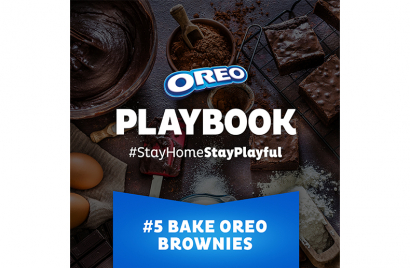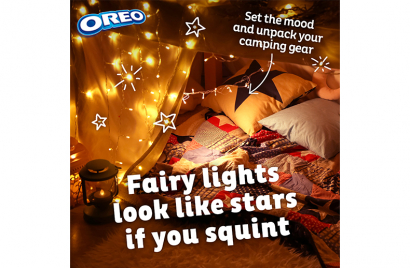
Dr. Martens champions sustainable fashion
Genix Nappa, a new material made of leather offcuts, aims to reduce waste

Oreo and Digitas on how vulnerability empowered a creative partnership under lockdown.

When lockdown came into effect, schools closed, families, friendship groups and couples were confined to the four walls of their homes and flats. Parents became teachers, flatmates, colleagues and siblings’ classmates as the lockdown entered its second, third and fourth month. Working from home became, for many parents, carers and guardians, an exercise in extreme time management, a juggle that continues even as the nation begins to slowly emerge from the toughest constraints of lockdown.
Alongside home schooling of course, comes the need to entertain, to find moments of connection with those who live under the same roof. The need to stay playful amongst the uncertainty and anxiety became even more important. Light relief was a necessary moment of escape.
For Oreo, this was a space that they felt they had the right to play in. As people and parents increasingly ran out of ideas and sanity, the brand teamed up with their agency partner Digitas to create a Playbook of activities that would bring families closer together as they sought to offset the horror of the unrelenting news cycle.
The campaign’s aim was to bring some much-needed light relief to lockdown through a socially led campaign featuring 15 fun activities promoted with #StayHomeStayPlayful. The campaign itself was pulled together in just four days after the initial project the team had been working on since January was scrapped.
After the Digitas team presented the #StayHomeStayPlayful idea to their Oreo partners, the brand immediately recognised the values it reflected, of connection, playfulness and the home. James Whatley, Strategy Partner at Digitas and Aislinn Campbell, Senior Brand Manager at Oreo spoke to Creativebrief’s Editorial Director Nicola Kemp about how their creative partnership only thrived in the face of the crisis, creating a space for openness, honesty and brilliant work.
It took a lot of bravery to say we need to down tools on that idea.
Aislinn Campbell
Campbell herself had only been in the role at Oreo since lockdown began, having joined the team in March of this year. Indeed, Whatley and Campbell still have yet to meet in person. But, as Whatley explained: “At the time, you’re only living in the moment that you’re in.” The agency didn’t just have a pandemic strategy in the bottom drawer; they had to adapt, and fast.
Campbell elaborates on the moment, on the 23rd March, when the country went into lockdown and the team decided a totally new campaign was needed: “We all had to stop and take a look at ourselves and think, is this still the right thing for us to be doing? Is it relevant and are people going to engage with it in the same way? It took a lot of bravery to say we need to down tools on that idea that we all loved at the time, and pivot to something that felt more relevant and in keeping with how drastically people’s lives had changed.”
Whatley laughs as he recalls the madness of the first few days in lockdown: “There were literally three days from March 23rd to March 26th where we pivoted. I get the shakes thinking about it now!” He credits the team around him at Digitas as the reason why the work could be pulled together in such a short space of time. “There’s an immense amount of trust and faith in each other,” he says.
While the team had been following the news since the start and, as Whatley explains: “had some work in the back pocket just in case,” it was definitely nowhere near client ready. “The agency term is probably embryonic,” he adds.
But there was no time for ego or creative stalling. “On the 25th we said we might have an idea and Aislinn called our bluff and said show us, we don’t have any time. Show us what you’ve got,” Whatley explains. Campbell approved the work the next day. It was perhaps that leap of faith that embedded a degree of vulnerability deep into the way the teams were operating with one another. Because to show an idea at its very conception, pre-polishing or edits, in its non-perfect state, is perhaps one of the more vulnerable things a person can do.


The first thing the team decided to do was that they’d run the work across social media, a natural fit for a brand like Oreo that is, Campbell says, “a very digitally centric brand.” Oreo wanted to engage with people where they were, to see what they were doing in their homes when they weren’t able to leave them.
“We were coming from a place of genuinely just wanting to help and provide some inspiration to people who were stuck in and bored and going a bit crazy,” Campbell explains. “And to immerse yourself and insert yourself into that conversation, social media felt like the right channel to do that without it coming across too forced.”
The team trod the fine line with the campaign between wanting to inspire people without just adding things to their to do list. Whatley explains that the original creative idea that was scrapped was around getting people to be less busy, to put their devices down and reconnect as families. They conducted research around what people did at home when they weren’t busy; this research was able to infuse the new campaign.
The essential question asked of the activities that were being imagined was, can it be done with one pack of Oreo? “It needs to be an easy thing to escape to,” says Whatley. “All of it is rooted in accessible playfulness without coming across as condescending or puerile,” he adds. “All of a sudden something as simple as baking brownies becomes the highlight of a day and becomes the activity that brings the family together,” says Campbell.
She emphasises how important it was for Oreo to stay top of mind as people were craving moments of familiarity: “Oreo is having a really good time of it at the moment because of that familiarity and because people are wanting to treat themselves in a way that feels safe.” Key to that was ensuring that tonally the campaign landed right.
For Whatley that meant stepping outside the way he’d usually operate with a social campaign to run solely organic content first, before launching the paid. “We wanted to test the water. No one’s sat at home going, I wonder what Oreo thinks about the pandemic? So, how do we make sure we’re entering people’s lives in a light way,” he explains. It became a vital moment in the campaign’s success, allowing the team to tentatively check the messaging and creative before throwing all their weight behind the paid content.
Getting those stars to align is very, very difficult in any point in time, in any year, let alone in the midst of a pandemic when everyone’s thinking about pulling budget.
James Whatley
“In so many ways, done is better than perfect,” said Kemp as the conversation turned to the partnership at the heart of the work. That element of slightly working on the fly strengthened it from the off. For Campbell, it was essential that the process was a collaborative one: “Yes, we might not have all the answers but let’s just figure it out together.” She is appreciative of the openness of the Digitas team who showed work before it was ready to be shown. “I love working like that. I’d much rather us evolve it together and be brought in early,” she adds.
Whatley acknowledges that at the height of the campaign, daily communication was key. He praises Campbell’s ability to line up the approval needed on the Mondelez side to ensure the work could get through quickly. “Getting those stars to align is very, very difficult at any point in time, in any year, let alone in the midst of a pandemic when everyone’s thinking about pulling budgets,” he says. “That was really, really empowering.”
He referenced the work of the American professor Brené Brown who believes that from vulnerability comes immense trust. It was a “galvanising moment” of vulnerability that the agency found themselves in when they showed their work in its non-perfect state. “Since then, we’ve never really looked back,” says Whatley. It’s a way of working that Whatley believes will only benefit future campaigns.
Traditionally there can be a lot of theatre within brand agency relationships; presentations can feel quite produced. But this process, says Campbell, felt entirely removed from that: “we were making decisions and we were running quickly and were aligning as we went but we were really empowered as well.”
The trust, honesty and openness at the heart of this process are, for both Whatley and Campbell, essential working tropes that both are hoping will continue to remain at the heart of the brand and agency’s creative partnership. For Whatley, the team set the tone from the beginning with the first presentation: “It’s a case of well this is as good as it is now, do you want to see it now?”
He explained that the partnership the team also had with the media agency Carat was also fundamental to the success of the campaign. “The way that we’ve shared the vulnerability and the work and the trust with Carat has done exactly the same thing in that relationship,” he adds.
Moving forwards the teams are talking every day, asking questions and sharing ideas. And always ensuring that their video is on for presentations. Campbell and Whatley joke that there was a clear agency brand split between video use at the start but that, as time went on, the teams realised how essential it was to actually see one another, even if it was just through a screen.
Whatley feels that the moment of intensity that this campaign was born out of is a point which brands and agencies typically reach after a few years of working together. “We got there straight away,” he says. He talked of a presentation he’d given to the whole Digitas team in which he retrospectively looked at the campaign and the work done under lockdown. The final slide of the deck, he says, “was trust your team, trust your clients, trust the work.”
Through a campaign turned around in just a matter of days, Oreo and Digitas brought playfulness and connection into homes across the UK under lockdown, proving that being vulnerable and imperfect is sometimes the best way to get brilliant work out into the world at breakneck speed.
To watch the full interview, visit the dedicated Creativebrief Explores page.
Tune in at 2pm on Thursday 13th August as we explore how CALM and adam&eveDDB worked together to control our online COVID consumption.
Looks like you need to create a Creativebrief account to perform this action.
Create account Sign inLooks like you need to create a Creativebrief account to perform this action.
Create account Sign in